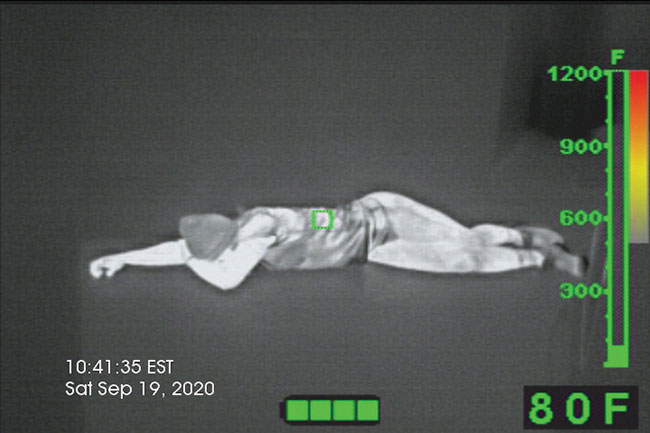
Features
Fire & EMS
Heat signatures can be masked
The importance of using your TI and your eyes
August 20, 2021
By Manfred Kihn
 If your TI is in the wrong mode, you could easily miss your victim as they will not be as visible to you or will be masked.
Photo credit: Bullard
If your TI is in the wrong mode, you could easily miss your victim as they will not be as visible to you or will be masked.
Photo credit: Bullard When looking through the lens of a thermal imager (TI), what is it that you are looking at? We know the basic TI’s shades are white (objects are hot or warm) black (objects are cold or cooler) and everything else is different shades of gray.
But that was not the question. The question was, “what is it that you are looking at?”
In answering this question, consider that infrared radiation (I/R) is heat that comes from many sources of molecular activity:
- Passive emitters: These primarily absorb and dissipate IR energy from active or direct emitters (inanimate objects such as tables, chairs, beds, or other furniture).
- Active emitters: Emit IR energy in low to medium strength and varying intervals (living organisms such as humans, animals and plants).
- Direct emitters: Constant high strength IR energy emitters (energy sources such as televisions, kitchen appliances, clock radios, cordless phones chargers, or computers).
When conducting a victim search, you are looking through the lens of a TI to aid you, but you should still you use your naked eye too, if conditions permit. Look for obvious forms or shapes of victims as they could be in different configurations like sitting, laying down or curled up. Not all are going to be visible as they could also be varied in different colours from white, black or grey depending on the temperature of the room or environment that they are located in.
In a bedroom, heat signatures can be masked depending on the type of bedding being used, such as a thick duvet, and Mrs. Smith, who is a frail elderly woman with not a lot of body mass, can be easily missed. You cannot rely on the TI alone. To be on the safe side, you must also conduct a manual search of the bed on top and under it. You could also be picking up what I call nuisance heat signatures that will be produced by direct emitters found on night stands next to the bed, but since you practice lots with your TI you would understand what those will look like…right?!
In elevated temperature situations, you must understand the difference of the sensitivity modes or gain states that your TI can produce and is indicated by a small green box with a green triangle inside found in the upper left-hand corner of your display screen. In the wrong mode you could easily miss your victim as they will not be as visible to you or masked. I call it “tricking the imager” by lowering or pointing the imager at the floor to get it to switch modes from low gain back to high gain so it’s sensitivity will be more focused at lower temperature objects such as your victim, and not the heat from the fire or unmasking the heat signature this time.
Another heat signature that is masked is that of a fellow firefighter due to the wearing of PPE. Looking for the shape of a helmet, SCBA and facepiece are important notes for the RIT team.
We can unmask some other heat signatures by scanning with our imager slowly and methodically. If you scan too quickly, how can your brain compute what it is that you are looking at? I would love to hand you a silver platter with different shapes, sizes and colours of said heat signatures for you to look at and figure out, but I can’t. You’ll know this because you practice lots…right?!
Another area where heat signatures can be masked is when conducting size-up of a structure. Let’s say that the structure is made up of red rough brick on all four sides and has an asphalt shingle roof (both materials have a high emissivity value to them). Let’s make it a sunny day and you have a challenge on your hands. It is vitally important to conduct a thorough 360 of this structure as any heat from the fire inside can now be masked by the angle and direction of the sun on the walls outside exposed to the sunlight.
TIs may also miss detecting a basement fire when scanning the ground level floor. This is because the wood flooring, along with carpet and laminate floor covering, tend to insulate and prevent heat transfer, again masking the heat signature. It is imperative to try to gather as much information with the TI and your naked eye.
Remember these key firefighter safety objectives when using a TI: Identify hazards, personnel accountability, identify emergency egress points and evaluate structural integrity. A TI is absolutely useless in the hands of an inexperienced operator as you have it to interpret it. The imager cannot do it for you.
Until next time practice, practice, practice and stay safe.
Manfred Kihn is a 19-year veteran of the fire service, having served as an ambulance officer, emergency services specialist, firefighter, captain and fire chief. A member of Bullard’s Emergency Responder team since 2005, he is the company’s fire training specialist for thermal imaging technology. E-mail him at manfred_kihn@bullard.com.
Print this page